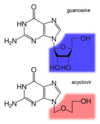2-25 Antiviral Drugs Flashcards
What are some viruses that are treatable with antiviral drugs?
- Hepatitis C
- HIV
- Flu
- Croup
- Warts
- Systemic adenovirus
- Hepatitis B
- Some herpesvirus
- Smallpox
What are some types of antivirals?
- Nucleoside analogs (“Nucs”)
- Non-nucleosides (“Non nucs”)
- Protease inhibitors
- Entry inhibitors
How do antiviral drugs work?
- Target essential virus functions: entry, uncoating, genome replication, assembly, release from cell
- Target host cell defenses (intrinsic immunity): interferon pathway
- Activate immune response

How can antiviral drugs be involved in the nucleotide synthesis pathways?
- Many antivirals are nucleoside analogs that compete for the enzymes in the purine and pyrimidine synthesis pathways
- Viral enzymes are also involved
What are some important problems with antivirals?
- Specificity: most drugs target functions of only one virus; broad-spectrum drugs are rare (high viral mutation rate)
- Cytotoxicity: “off-target” effects can harm cells; “on-target” drugs directed at viral enzymes can be defeated by resistance mutations
- Duration of antiviral effects: most drugs are reversible (competitive inhibitors); virus replication can resume when drug is cleared (rebound); treatment might need to be life long!
How is resistance a problem for antivirals?
- Resistance mutations often exist in a patient BEFORE drug treatment
- Drug treatment selects for resistant virus strains
Factors that increase resistant variants:
- High rate of virus replication
- High mutation rate (RNA viruses >> DNA viruses)
- High selective drug pressure (long-term or multiple treatments)
- Immunosuppressed host that cannot clear virus-infected cells
How do we counter resistance to antivirals?
- Alleviate immunosuppression: reduce doses of anti-T cell drugs (steroids, cyclosporin, etc.)
- Combine drugs with different targets (standard of care for HIV and HCV infections): drugs with different mechanisms of action synergize; lower probability that multiple resistance mutations will be present
- Target host functions: infected cells may have unique profile that can be a drug target; virus mutations do not impact cellular genes (some cancer drugs target dividing cells and also inhibit viruses)
BUT beware of toxicity!
Who should be treated for HSV-1, HSV-2, and VZV?
(With acyclovir.)
- Neonates infected w/ HSV at birth
- People with freq. recurrences (Type 1 or 2)
- Complicated HSV infections: encephalitis, dissemination throughout body, eye infxns
- People w/ zoster (w/in 3 days of appearance of rash)
What is acyclovir?
An antiviral treatment for HSV-1, HSV-2, and VZV.
- Nucleoside analog of guanosine
- Effective against: HSV-1 = HSV-2 >> VZV
- Trade name: Zovirax
- Derivatives: Valaciclovir (Valtrex), Penciclovir (Denavir), Famciclovir (Famvir)

What is the mechanism of acyclovir?

What is ganciclovir?
An antiviral treatment for CMV.
- Nucleoside analog of guanosine
- Ganciclovir = Cytovene; derivative: Valganciclovir = Valcyte
- Similar mechanism of action to acyclovir
- Highly toxic: suppresses bone marrow, mutagenic and teratogenic, severe side effects
Who should be treated?
- Bone marrow and organ transplant patients
- Immunosuppressed people w/ active CMV
- Patients w/ CMV retinitis
What are some “broad-spectrum” treatments
for DNA viruses?
Foscarnet (Foscavir):
- Trisodium phosphonoformate
- Inhibits viral DNA polymerase
- Effective against all herpesviruses
- I.V. route only
- Toxic to kidneys
Cidofovir (Vistide):
- Nucleoside analog of cytosine
- Effective against DNA viruses: herpesvirus, adenovirus, papillomavirus, poxvirus
- I.V. route only
- Toxic to kidneys
What are antiviral treatments for HBV, and who should receive them?
HBV is treated with drugs designed for HCV and HIV. Current drug options:
- Pegylated interferon alpha (PEG-IFN-α) = Pegasys
- Entecavir = Baraclude
- Tenofovir disoproxil fumarate = Viread
Who should be treated?
- People w/ chronic active HBV disease
- People co-infected w/ HCV and/or HIV
- People who are progressing to cirrhosis, liver failure, or hepatocellular carcinoma
Who should be treated for influenza virus?
- The severely ill (hospitalized)
- Children < 2yo
- Adults > 65yo
- Pregnant women
- Immunosuppressed people
- ANYONE suspected of having influenza
What are the treatments for influenza virus?
Zanamivir (Relenza) and Oseltamivir (Tamiflu).
- Both are sialic acid analogs that inhibit viral neuraminidase (sialidase)
- Virions remain attached to cell
What is Ribavirin?
An inexpensive, OTC, “broad-spectrum” medication for RNA viruses.
- Nucleoside analog of guanosine
- Oral, I.V., and aerosol formulations
- Approved for use against HCV and RSV
- Off-label use: HSV, influenza, SARS, and MANY others
What is AZT?
Zidovudine, the first drug for HIV. Now an “antique.”
- Nucleoside analog of thymidine
- “NRTI” class (Nucleoside Reverse Transcriptase Inhibitor)
What are the classes of anti-HIV drugs, and how are they typically used?
- Entry inhibitor: Maraviroc (Selzentry)
- NRTI (Nucleoside/tide RT inhibitor): Tenofovir (Viread), Emtricitabine (Emtriva)
- NNRTI (Non-nucleoside RT inhibitor): Efavirenz (Sustiva)
- IN (Integrase inhibitor): Raltegravir (Isentress)
- PI (Protease inhibitor): Darunavir (Prezista)
They are typically used in combination.
What is Stribild?
A four-drug combination for HIV that can be given in one daily pill.
- Elvitegravir: integrase
- Cobicistat (boosts potency of elvitegravir): liver enzyme
- Emtricitabine: reverse transcriptase
- Tenofovir disoproxil fumarate: reverse transcriptase


